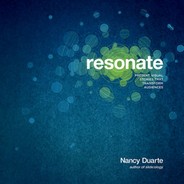108 Resonate
Recall Stories
Most great presentations use personal stories. As you
create the content, there will be places where you want
the audience to feel a specific emotion. Recalling a time
when you had that very same emotion connects the
audience to you in a credible and sincere way. Creating a
personal catalog of stories associated with various emo-
tions is a useful resource.
One instinctual way to recall stories is to reflect upon a
timeline of your life. You can go year by year or cluster
the years into phases like early childhood, elementary
age, middle school, high school, college, career, parent-
ing, grandparenting, and retirement.
However, drumming up memories based on chronology
is only one way to do it. Breaking the chronological pat-
tern can help recall a deeper—and possibly dormant—
set of stories. Think about people, places, and things
instead. As you explore these areas, draw sketches
of what you see and jot down as many memories and
emotions triggered as possible.
People:• You can evoke relational memories by
capturing a list of the people you’ve known. Start
by creating a hierarchical family tree that displays
familial bonds. Then, begin connecting and linking
relatives to each other outside of the hierarchical
lines based on exchanges or situations in which
they interacted in some way. List other people
you’ve known who’ve influenced you and relation-
ships you’ve observed: teacher/student, boss/
co-worker, friend/enemy. These kinds of power
dynamics make exciting stories. Think through the
relational dynamics and feelings you have toward
each person.
Places:• Carefully think about spaces where you’ve
spent time: homes, yards, offices, neighborhoods,
churches, sporting facilities, vacation sites—any
place, even virtual spaces. Use your memories of
these to transition into spatial recollection. Mentally
move from room to room, drawing as many details
as you can remember. You’ll “see” things you’d for-
gotten. Visually moving from one space to another
will trigger scenes and even long-disregarded scents
and sounds. Changing gears to sketching allows you
to use a different part of your body and brain, which
can loosen more memories.
Things:• Try to catalog the material things you’ve
possessed in your life that you deem valuable. They
don’t have to have been expensive items—just sen-
timentally significant. Why were they so precious to
you? Did you love your old jalopy because you had
your first kiss there? Or your old teddy bear because
it comforted you when you had your tonsils out?
What are the stories behind these items that make
them important to you? Sketch a picture of them
with as much detail as possible in the environment
where they were usually found. This will trigger even
more emotions and memories.
Sketching these memories is a great way to classify and
recall stories. If you’re uncomfortable sketching, find
images to represent the stories. Create a visual trigger
and jot down as much of the memory as you can—espe-
cially how you felt as the story unfolded. You can refer-
ence this collection of stories whenever you need to tell
a personal anecdote with conviction.
CH005.indd 108CH005.indd 108 8/16/10 4:25:54 PM8/16/10 4:25:54 PM

Create Meaningful Content 109
When I get creatively stuck, I bounce back and forth
between writing and visualizing. This process sparks
new ideas, metaphors, or visual explanations.
I once needed a story for a presentation that communi-
cated staying calm under pressure. I wanted to draw from
a real childhood memory. Instead of recreating my youth
chronologically through a timeline, I drew the floor plan of
my childhood home to trigger visual memories. My brain
traveled through each room, recalling dormant memories
of my lost turtle, stage productions in the basement, and
other vivid images.
But most importantly, I found my story. While drawing
the floor plan of the upstairs, a memory of my four-year-
old little sister, Norma, came flooding in as I sketched a
closet door. She’d accidentally locked herself in the closet.
The lock was made in the early 1900s and was on the
inside of the closet. It had a difficult two-step process that
involved turning a dial and moving a lever sequentially to
open it. I felt helpless and clawed at the door from the
outside while she screamed on the inside. My grandfather
ran off mumbling something about finding the ax. Images
of a bloody mess shot through my mind; I had to do
something. I quieted Norma down enough to explain the
choice of having Grandpa hack the door down or calming
down and listening to my instructions. On her tiptoes, she
carefully turned the knob, pressed the switch, and was
freed just as Grandpa ran back into the room. I knew she
could do it, but only with calm, persistent determination.
The story worked perfectly!
CH005.indd 109CH005.indd 109 8/16/10 4:25:54 PM8/16/10 4:25:54 PM
..................Content has been hidden....................
You can't read the all page of ebook, please click here login for view all page.
